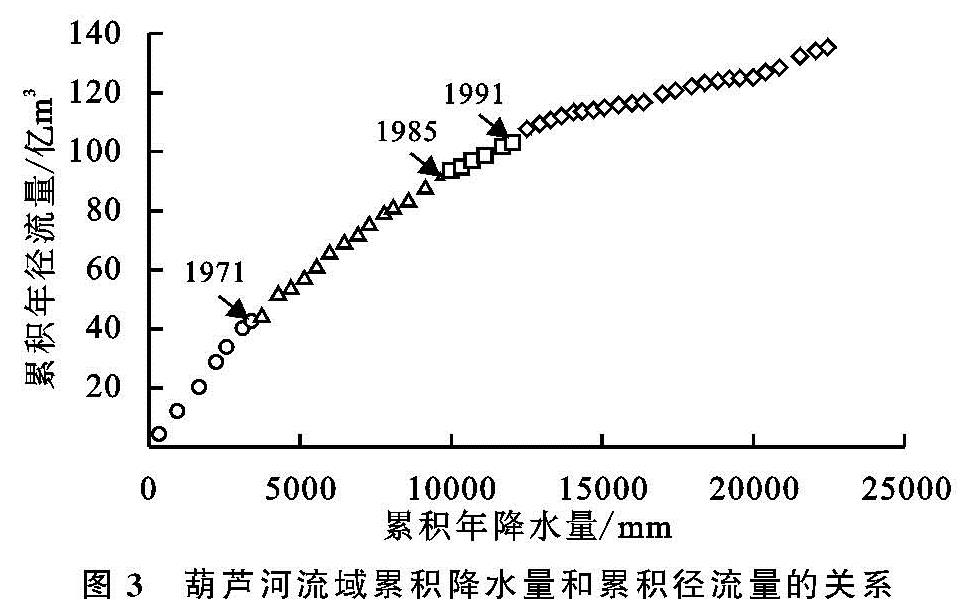3.1 流域降水量及径流量年际变化特征
由1965—2015年葫芦河流域年降水量年际变化图(图1A)可知,葫芦河流域年降水量在整体上呈减少变化趋势,但趋势不显著。51 a以来流域多年平均降水量为441.01 mm,其中最大年降水量为719.10 mm(1967年),最小年降水量为285.54 mm(1997年)。1965—2015年期间,年降水量小于300 mm的年份有2 a,比例为3.92%; 年降水量大于600 mm年份有4 a,比例为7.84%。可见,葫芦河流域年降水量为300~600 mm。
如图1B所示,1965—2015年葫芦河流域年径流量整体呈显著减少趋势,且年径流量的变化幅度明显大于年降水量的变化幅度。51 a期间流域内多年平均实测径流量为2.65亿m3,其中最大年径流发生在1968年,年径流为8.48亿m3,最小年径流发生在2009年,年径流仅为0.27亿m3,径流量的极值比达31倍。1990—2012年期间的年均径流量仅为1.28亿m3,不超过多年平均值的50%,而1965—1974年期间的年径流为5.37亿m3,超过多年平均值的50%。由此发现90年代以来,该流域径流减少幅度明显。
3.2 流域径流量突变特征分析
3.2.1 基于累积距平法的径流量突变年份分析
采用累积距平法分析了葫芦河流域年径流量时间序列的突变点(图2)。由累积距平结果知,1965—1971年年径流量维持在一个较高水平,1972—1985年的年径流量较前一段有所减少,但仍高于多年平均值,表现为年距平累积继续呈增加趋势。在1971年前后发生了第1次较明显的突变,年径流量趋于减少; 1985年后发生了第2次突变,表现为年径流量已减少到低于均值水平以下的变化; 1991年发生了第3次突变,1991年后年径流量在均值以下快速减少。由1965—2015年累积距平的结果与分析,径流量发生突变年份为1971年、1985年和1991年,可划分为4个阶段:1965—1971年、1972—1985年、1986—1991年及1992—2015年。
图1 1965-2015年葫芦河流域降水量和径流量的年际变化
3.2.2 基于降水量和径流量双累积曲线的径流量突变分析
赵广举等[23]对华县、花园口等6个水文站点采用径流—降水累积曲线,判断出各个站点的径流突变点。侯钦磊等[24]采用降水—径流双累积曲线法分别判断出林家村站、咸阳站和华县站3个水文站点的径流突变点以及划分其基准期和研究期。张艳霞等[25]研究锡林河流域径流量变化对气候变化与人类活动的响应,采用径流—降水累积曲线识别锡林河流域径流突变点为1984年、2000年,进而可划分为1968—1984年、1985—2000年和2001—2015年。故在累积距平法判断出葫芦河流域径流量突变年份的基础上,采用降水量和径流量双累积曲线识别径流量时间序列的拐点年份,通过比较验证突变年份选取的合理性。当只有降水变化时,双累积曲线呈一条直线; 当受到人类活动等其他因子影响时,曲线会出现拐点,且偏移程度越大,说明人类活动等影响越大,据此可判断出开始受人类活动影响的时间和人类活动影响程度[23]。由降水累积量和径流累积量双曲线图(图3),在降水和人类活动的共同作用下,双累积曲线的斜率在1971年、1985年、1991年发生显著变化。分析双累积曲线不同阶段趋势变化可知,曲线在1971年发生了第1次偏移,第2次和第3次偏移分别发生在1985年和1991年。一般将降水量和径流量双累积曲线开始发生显著偏移前的一段时期作为基准期,该时期内的年径流量未受人类活动的严重干扰,可看作为近似天然径流阶段[24-25]。因此,结合累积距平和双累积曲线的结果,将葫芦河流域径流量序列划分为4个年段,1965—1971年作为葫芦河流域的基准期,1972—1985年、1986—1991年、1992—2015年分别作为研究Ⅰ,Ⅱ,Ⅲ期。
进一步分析基准期累积径流量和累积降水量的相关程度,建立基准期累积径流量和累积降水量的一般线性回归模型和基于机器学习的支持向量机回归模型。由
表2中两种模型计算的判定系数R
2结果比较,支持向量机回归模型较一般线性回归模型拟合较好,故下节选用此方法计算降水和人类活动对葫芦河径流的贡献率大小。
3.3 影响径流量的驱动因子分析与贡献率计算
基于前节模型的比选,根据基准期1965—1971年内降水量和径流量的年系列资料,由公式(8)计算,建立方程如下:
R=1.25+0.0097P, r2=0.7839(9)
式中:R为年平均径流量(亿m3); P为年平均降水量(mm)。
公式(9)反映了降水量和径流量的关系变化,在1965—1971年期间,随着降水量的增加,径流量呈现增加变化。根据上述方程和已知降水数据便可算出各时段自然状态下的径流量。而基准期的实测径流量与其差值便为该时段降水变化对其径流变化的影响值,各时段径流实测值与基准期径流实测值的差值即为总减少量,而人类活动影响量便是总减少量减去降水变化的影响值[26-27](表3)。
3.4 水保工程措施对径流量的影响分析
20世纪以来,葫芦河流域开展了大量的水保工程措施,为有效治理黄土高原区自然环境脆弱和水土流失严重等问题。这些水保工程措施作为该流域主要的人类活动,其中退耕还林和淤地坝工程措施对黄土高原区的径流量影响较大,且退耕还林工程的水土保持效果更加显著[28-29]。基于该流域(甘肃段)2003—2012年水保措施和径流量(甘肃段流域)资料,进一步探讨不同的人类活动对葫芦河流域径流量的影响重要程度。基于机器学习的SVM回归模型建立不同水保工程措施与径流量的关系式,如下:
Y=-0.0038X1-0.0019X2+5.1089(10)
式中:Y为年平均径流量(亿m3); X1为退耕还林总面积(km2); X2为已修建淤地坝的控制面积(km2)。
由上式系数分析可知,退耕还林和淤地坝措施与径流量呈负相关,即退耕还林和淤地坝的规模逐年增大,葫芦河流域的径流量逐年减少。由于这些水保工程措施实施,故将部分径流留在了当地,与实际情况一致。退耕还林工程的系数权重大于淤地坝措施的系数权重,揭示了退耕还林工程是影响该流域径流量的主要人类活动方式。根据黄河水利委员会统计的水保资料,该流域(甘肃段)2003—2012年每年退耕还林总面积都远大于淤地坝工程总控制面积,约为淤地坝工程总控制面积的6~8倍。由于淤地坝常年泥沙沉积,使有效控制面积不断减小,从而影响其水土保持效益,而退耕还林工程的水土保持功能具有一定的持续性,则退耕还林工程是减少水土流失的主力军[29]。故深入研究葫芦河流域不同水保措施对径流量的影响,对探究水土保持效益和制定水土保持规划有着重要意义[30]。






